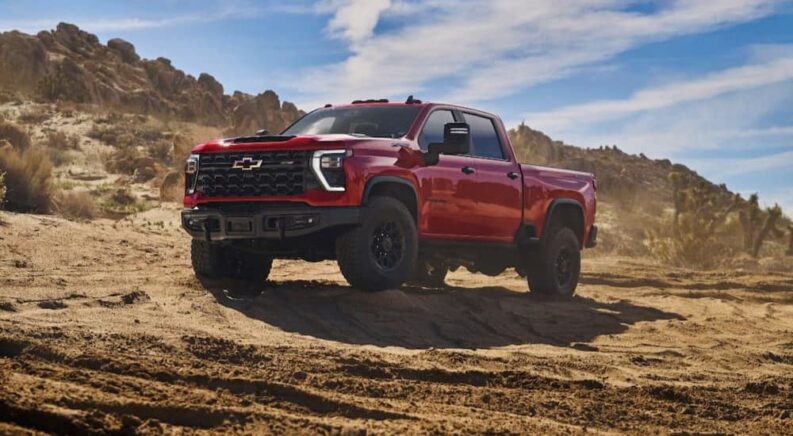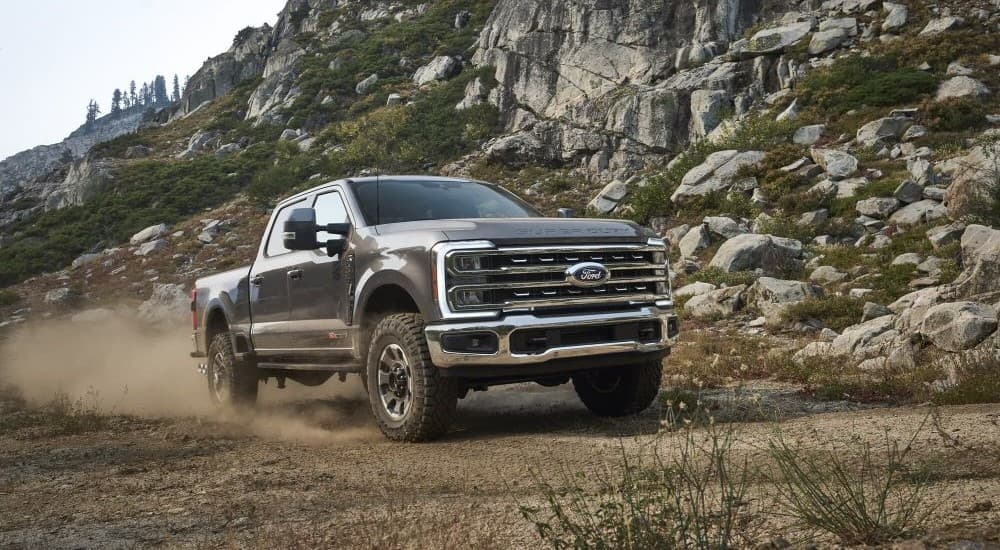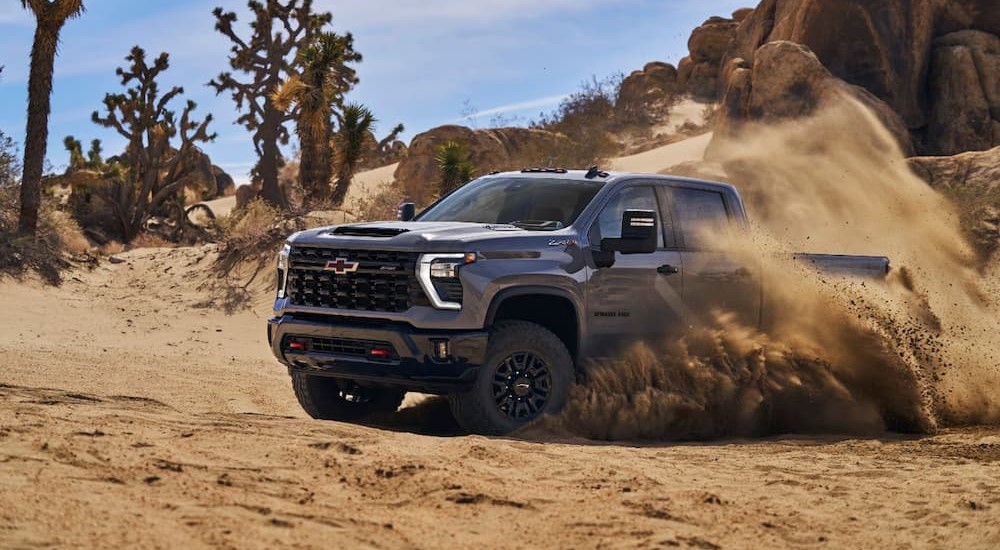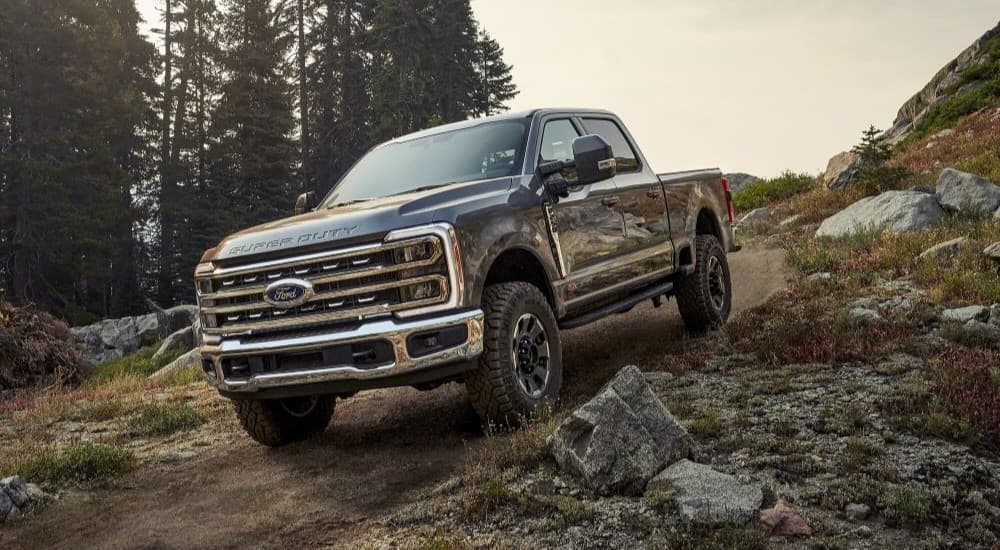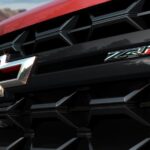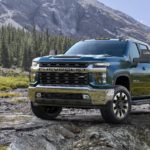How do you classify a three-quarter-ton pickup that can jump dunes, conquer rocks, and wreck forest trails by kicking up more dirt than Mount Semeru can kick lava into the sky? Tradition says you should pack that awesomeness into overly generous trims and slap a cool name on them. So when you want some super-beefy trucks to venture off-road, you’re likely looking at Ford or Chevy, and what’s better to lure you in than the Silverado 2500 HD ZR2 or the Ford F-250 Tremor?
Both of these trucks sit at the top of the mountain of heavy-duty off-road machines, so whether you’re at a Chevy Silverado 2500 dealer, haggling on an off-road three-quarter-ton pickup, or at a Ford outlet, schmoozing for a Super Duty daredevil, you’re going to want the best that the segment has to offer. But how well do they fare against one another, and how could you declare a champion? That’s what we’re here to break down today, giving you all the ins and outs of what you can expect from two of the most popular heavy-duty off-road models on the market today.
Angling for Perfection
Part of the biggest selling point for off-road pickups is being able to surmount difficult terrain; this is already a difficult task for compact pickups, but it becomes more challenging for longer full-size pickups, and it becomes herculean for larger heavy-duty models. Why? Because there is way more mass to move around, and if you’re venturing off-road while also towing or hauling cargo, it adds a lot more demands to the truck; it can also result in squatting.
Squatting is where the suspension is weighed down due to the gross weight of the vehicle’s cargo; this can greatly impact your vehicle’s angles of departure, approach, and breakover angles.
For heavy-duty pickups like the Silverado 2500 HD and Ford F-250, the angles are a lot more impressive for their off-road models than you might be expecting. The F-250 Tremor, in four-wheel drive, has a max departure angle of 24.5 degrees and a ramp breakover angle of 21.9 degrees; the max angle of approach is 31.6 degrees. These give you plenty of maneuverability on and off the road, but interestingly enough, it still comes up a bit short compared to the Silverado 2500 HD ZR2.
The ZR2 is an absolute beast in its specs, and its max approach angle is 32.5 degrees, which is a pretty significant step up from the Super Duty. The Silverado HD ZR2 has a breakover angle of 21.2 degrees and a departure angle of 25.7 degrees; these are impressive figures for the ability to angle over, around, up, or down various types of topographical changes.
What you end up with is a stark difference in approach (pun intended) to how these vehicles have been engineered to deal with off-roading tasks. Then again, this is also because the F-250 Tremor is a package rather than a standalone trim like the Silverado 2500 HD ZR2. So you’re basically taking an F-250 that wasn’t designed specifically for off-roading and adding a package that makes it more off-road-ready. Even still, the differences aren’t major in the angling of the two trucks, but they absolutely favor the Silverado 2500 HD ZR2 where it counts because it was purpose-built for the challenge.
Great Ground Clearance
Ground clearance is extremely important when you’re using your heavy-duty truck off-road. Once again, much like how the weight of the cargo can cause a vehicle to squat, it can also affect a vehicle’s ground clearance. You may lose an inch or two due to the cargo you’re carrying, which means you need a base ground clearance high enough to clear obstacles if the truck is fully loaded.
For off-road trucks, high ground clearance is an absolute must to get the best performance and utility out of it—and when you look at the Silverado 2500 HD ZR2 and the F-250 Tremor, you can tell that they both focus on trying to provide as much clearance as possible.
The F-250’s Tremor Package comes with a suspension lift kit installed, giving you a boost of 0.6 inches, up from the standard 10.2 inches to 10.8 inches. It’s not a whole lot, but it’s enough to create separation from the base trims. Also, if you do have to deal with squat, it still gives you enough clearance to make use of the approach and breakover angles without the skid plates grinding against rocks and creating sparks. However, the F-250 Tremor’s ground clearance is not quite on the level of the Silverado 2500 HD ZR2.
You get 11.6 inches of base ground clearance with the standard ZR2, and you get close to a foot with the ZR2 Bison, which clocks in at 11.8 inches. So you get one whole inch on the F-250 Tremor package by comparison. If you’re averaging an inch of squat with a loaded truck, you still have more than ten inches of ground clearance with the Silverado 2500 HD ZR2 compared to the Tremor, which would be down to nine inches of clearance with an inch of squat.
But it all depends on the load; it depends on where you’re driving and how much clearance you need. The simple gist is that, with the 2500 HD ZR2, you have much more leeway, even accounting for heavy loads.
Suspension Supremacy
In speaking of squats and weight and how off-road performance is measured, a lot of it is optimized by a vehicle’s suspension. A reinforced chassis allows your suspension to improve how the vehicle handles off the beaten path, how it handles trailering and hauling, and how it handles recreational activities like rock crawling, hill climbing, or mudding. Part of the significance of that comes from having a solid suspension setup built on a strong chassis foundation.
The F-250 Tremor features a 4.30 electronic locking differential with the 7.3L V8 gas engine and a 3.55 electronic locking differential with the 6.7L high-output diesel. You’ve got 18-inch wheels paired up with 35-inch Duratrac tires as well as front and rear performance shock absorbers, two skid plates over the transfer case and fuel tank, water fording vent tubes, and a front limited-slip differential. These give you the necessary features to manage your off-road travels without worrying about getting stuck on simple rocky terrain or dirt trails.
On the opposite end of the spectrum, you have the Chevy Silverado 2500 HD ZR2, which is likewise designed to tackle off-road obstacles as efficiently as possible. The big difference, however, is that the ZR2 for the 2500 HD is based on the race-centric Silverado 1500 ZR2, which features a lot of patented tech that elevates its off-road prowess to the next level, simply beyond 18-inch wheels in 35-inch Goodyear Wrangler Territory MT tires.
Part of its secret sauce is in the Multimatic DSSV spool-valve dampers, which are oftentimes used in pole position race cars. This technology allows for dynamically adjusted damping to stiffen the suspension per the topography underfoot. It is a next-level technology that raises the profile and the bar for off-road traversal, putting the Silverado 2500 HD ZR2 into next-level territory.
What’s more, the 2500 HD ZR2 sports an electronic locking rear differential and multiple skid plates to cover the transfer case and the front of the vehicle. While those features are standard fare, the upper and lower high-performance control arms, and high-quality steering knuckles ensure you get precision handling without losing the heavy-duty truck’s functionality.
The Real Winner Is the Customer
The F-250 lacks features like the DSSV dampers, the ground clearance, and the angling differences, so you’re looking at a difference in off-road precision when it comes to these two trucks. Is it enough to get you to forego a Ford F-250 for a Chevy Silverado 2500 HD? That’s entirely up to you. But in terms of specifications for a heavy-duty off-road vehicle, the differences are big enough to warrant consideration for hardcore off-road enthusiasts.

